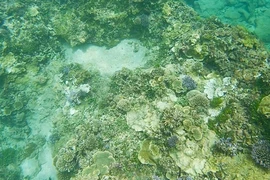Climate change, over development, and seafoodexploitation are threatening the life of coral reefs in a number of coastalareas in the province.
Dua Beach in Nhon Ly Commune, for example, iswell known for its diverse and distinct coral reefs. It covers a total area ofover eight hectares, however, only one hectare is strictly protected by localauthorities due to a lack of resources.
To ensure the remaining seven hectares areprotected from damage caused by fishing vessels and tourists, and to raisepublic awareness of the threats coral reefs face among the local community, theQuy Nhon city People’s Committee, last February, decided to hand overmanagement of the area to the Group of Seafood Resources Protection (GSRP), alocal community group.
Members went to work almost straight away andzoned off the areas with coral reefs by installing buoys to monitor and alertfishermen and tourists of their location so that they are able to avoid makingcontact.
Nguyen Viet Xuan, a member of the group, saidthe group also regularly organises patrols to educate people on how to interactwith the coral reefs safely and avoid damaging the fragile ecosystem. Thisincludes not stepping on or collecting coral to take home and not throwingrubbish into the sea.
Furthermore, the group has banned fishermenfrom using explosives to catch fish in areas with coral reefs, he said, andregularly organises patrol in these areas to ensure the ban is enforce.
Vice chairman of the Nhon Ly communal People’sCommittee Nguyen Thanh Danh, said the group members’ activities have helped toraise people’s awareness of dangers facing the maritime ecosystem and the coralreefs and how to better protect them.
“Over the past year, the coral reefs in DuaBeach have developed well thanks to the group’s protection. We hope the city’sauthorities will continue to authorise the local community to manage andprotect the coral reefs,” he said.
The city’s People’s Committee has done justthat.
The GSRP, in conjunction with Nhon Chau island commune,has been entrusted to manage and protect 12ha of coral reefs in the west of HonKho island and a 20ha area of coral reefs near Tuoc beach.
Nguyen Ton Xuan Sang, a member of the GSRP,said a number of proactive steps have already been taken to ensure theprotection of the area.
Buoys have been planted and vessels have beenbanned from exploiting fisheries in this area in order to protect the coralreefs and allow aquatic resources to breed and regenerate.
When the coral reefs are better protected, itwill help to attract more tourists, Sáng said.
Apart from supporting these groups to protectthe coral reefs, local officials are also regularly monitoring the health ofthe marine ecosystem by utilising local communities who are most familiar withthe areas.
Nguyen Hai Binh, vice chairwoman of the SeafoodAssociation of Binh Dinh province, local people assigned to protect the coralreefs know how the coral reefs in their areas are developing.
Coral reef ecosystems are a habitat for marinespecies, and help keep marine ecosystems in balance. They provide habitats andfood for fish and their destruction may lead to the extinction of some species,scientists have warned.
The Binh Dinh Fisheries Association, in 2018, introduced a projecttitled "Management and conservation of coral reef ecosystems associatedwith ecotourism development in Nhon Hai commune” to help raise awareness of thethreats posed to coral reefs. It encourages local communities to become involvedin their protection and promotes sustainable ecotourism to ensure coral reefscan be enjoyed long into the future./.






























